why use cloth diapers?
If you've arrived at this page, you likely know by now how much conflicting information is out there about whether using disposables or cloth is best for your baby, best for your family, best for the planet. Here are our top 4 reasons:
- 100% cotton is a natural alternative to some ingredients found in disposable diapers
- Babies go through 12 to 18 diapers per day as a newborn and 6 to 8 per day by toddlerhood—that’s 6,000 diapers in the landfill per child
- Earlier potty training
- Adorable patterned covers and no saggy bums
At Diaper Stork, we believe in cloth for three reasons: comfort, cost, and convenience. We also believe that only you know what is best for your family, so we are here to support (not pressure) you! Please feel free to
reach out to us if you have questions or need any information that will help you make a more informed decision.
comfort
Okay, none of us remember exactly what a diaper felt like when we were itty bitty. But given the choice between 100% cotton underwear and underwear made with plastics, polymers, gels, and crystals, we know which would be more comfortable! Add to that the fact that babies who wear cloth diapers experience way less diaper rash than babies diapered in disposables, and we think cloth diapers win the Comfort category, hands-down.
convenience
The number one concern of parents weighing cloth vs. disposable diapers for their little ones seems to be one of convenience and time. With cloth, you'll spend a day or two learning your favorite folding techniques. Given the 1.5 - 2.5 years that your baby will be in diapers, this is no time at all.
So, here is a nitty-gritty comparison of the actual daily process of using our cloth diaper service vs. disposables
- Diaper changes require an additional step of folding a cloth layer around baby before fastening the diaper cover (diaper covers have both snap and velcro-type closures)
- Dirty diapers are tossed into the provided diaper pail instead of the trash
- Once a week you'll place the diaper pail liner filled with dirties out on your front step
Here are a couple more convenience considerations, in no particular order:
- There are no "oh crap we're out of diapers" runs to the store
- Babies potty train up to 12 months earlier when diapered in cloth vs. disposable. That could mean more than 2,500 diaper changes that you don't have to do!
- The ability to get a perfect fit with prefold cloth diapers means no leaking and no blowouts. Instead of spending time changing crib bedding, washing poo out of Baby's [your] favorite onesie, or hunting down the stain remover for your [friend's] new rug, you're cooing over your beautiful baby.
cost
Environmental
We all know that there are things we can do to live more sustainably, but it's easy to feel as though your efforts are too small to make a difference. Given the 6,000 to 8,000 diaper changes your baby will go through by the time he or she is potty trained, the cloth vs. disposable diaper choice is one that can have a very real impact on the world we leave behind for our children and grandchildren. In the U.S. alone, we put around 20 billion disposable diapers into the
landfills each year (that's more than 38,000 every minute!). Each of those diapers takes 500 years to decompose....so, each diaper is being used for 2-3 hours and then put into a landfill where it will remain for the lifetimes of our children, and grandchildren, and great-grandchildren, and well... you get the picture.
What about the water? Yes, it does take water to wash and re-use cloth diapers, but a service like Diaper Stork uses less water than washing at home because diapers are processed in bulk. The water consumption per diaper is less than flushing the toilet. We believe there are far more ways to save on water before stressing over 1 to 2 extra washes a week, like 1 minute less of taking a shower, not flushing the toilet after you pee, turning off the water when you brush your teeth. That's our two cents!
What about compostable diapers? There are multiple brands of diapers that are 90+% compostable which is awesome! But these need to be composted in a commercial setting regulated for biohazard waste. They cannot go in your city compost bin, or in your backyard bin. Unfortunately, Washington state does not have infrastructure to compost diapers at this time. Diaper Stork is looking at ways to support composting in our municipality, so stay tuned!
Financial
Diaper Stork's flat monthly rate is on par with the more eco-friendly disposable options out there, especially given that your little one may potty train up to 12 months sooner with cloth diapers! We offer four different pricing levels. For the standard price of $121 per month, you receive 90 newborn diapers per week. This is equivalent to 31 cents per diaper. Newborn disposable diapers range from 22 cents to 31 cents per diaper depending on brand, sales discounts, and retailer. With disposable diapers, your weekly garbage will increase by approximately 13 gallons. Depending on your municipality this could increase your utility cost. For example, in Seattle it would cost $8.95 per month (as of May 2019) for a household to switch from the 20 gallon garbage bin to the 32 gallon bin. Over the lifetime of the baby, disposable diapers are cheaper than a cloth diaper service unless you factor in the benefit of earlier potty training (6 to 12 months earlier). The most economical way to diaper your baby is to purchase your own cloth diapers or rent our DIY cloth diaper bundle for $27/month and wash at home. See all price options.
plus... they're cute!
There is just no question that reusable cloth diapers and cloth diapering accessories are cuter and more fashionable than their disposable counterparts. Don't believe us? Check out some of our cloth diaper covers here!

should you wash at home or use a service?
There are 4 main factors to consider:
- Do you have convenient access to a good washing machine?
- Do you have help, do you like laundry, how good are you at multitasking with very little sleep?
- What is your budget? Washing at home is the most economical way to diaper the baby. There is an upfront investment of between $250 to $800 if you purchase, and $25-$40 per month if you rent.
- Do you have a preference on diaper style? With our service and most services, you are limited to a prefold diaper style. You have more options if you wash at home.
diaper styles and application
There are three main cloth diaper styles: prefold, pocket, and all in one. Personal preference, age of baby, and cost are common considerations when choosing your stash.
traditional prefold style
This is a two part system where you fold a cotton rectangle around baby and secure with a water proof cover. Baby goes through 3 to 5 different prefold sizes and 2 to 3 different cover sizes for optimal fit. The water proof cover comes in PUL or wool fabric and can be used over multiple changes until soiled.
Guide to putting on a cloth diaper.

fitted prefold style
This is a two part system where the absorbent layer is sewn in the shape of a diaper and secured with a water proof cover. Baby goes through 2 to 5 different fitted sizes and 2 to 3 different cover sizes for optimal fit. The water proof cover comes in PUL or wool fabric and can be used over multiple changes until soiled. Guide to putting on a cloth diaper. In the first 6 months of baby's life a fitted pre-fold maybe easier to put on than a traditional flat style prefold. When baby is older, and poop is less frequent, a traditional prefold put on as a pad fold is the easiest method to quickly change out a diaper.
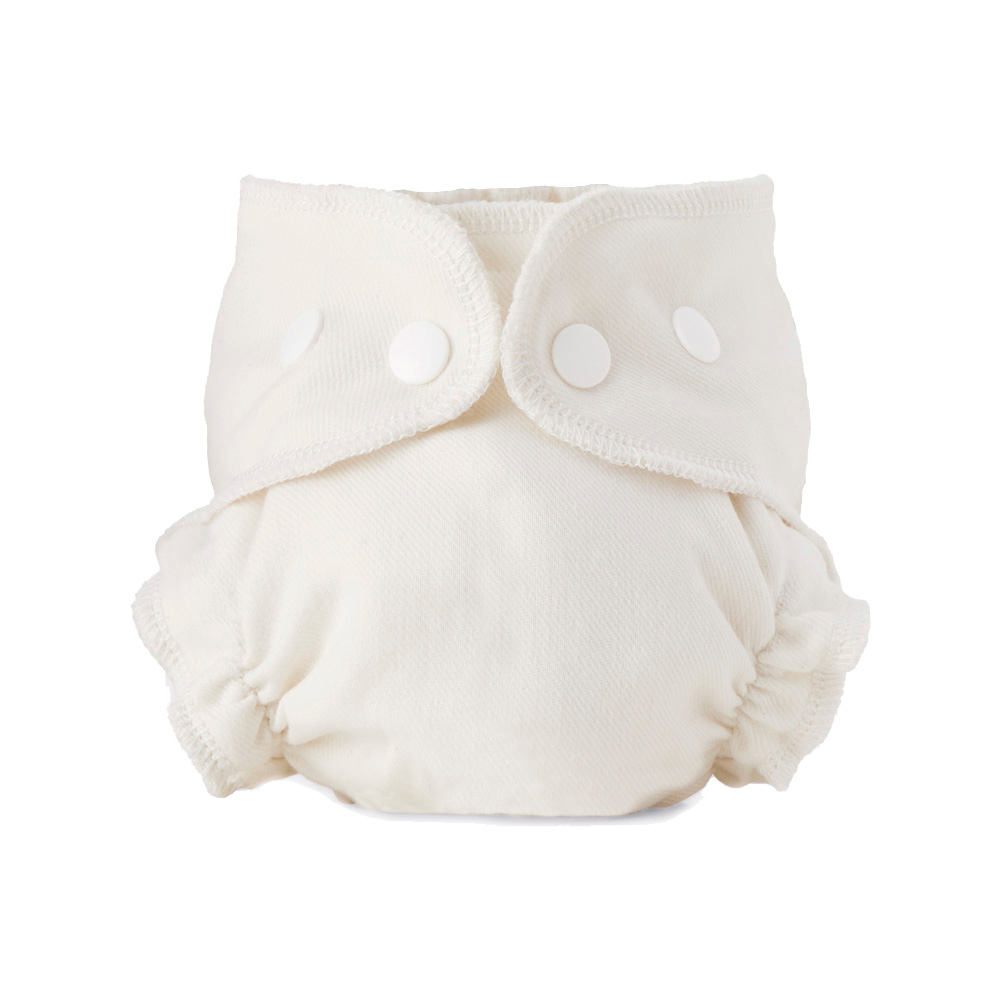
pocket style
The absorbent layer is stuffed into the pocket of this style diaper. It is one size fits all (8 to 40 lbs), but in reality it is quite large on a new baby and is better suited for when baby is around 2 months old. Both the absorbent layer and cover are washed after each use. After washing, the absorbent layer needs to be stuffed back into the pocket. This is a great overnight diaper because multiple absorbent layers can be added to the pocket and there is a micro fleece layer against baby's skin which has wick away properties to help keep baby dry. These cost between $8 and $28 per diaper depending on quality of materials and location sourced. The more expensive options have key features such as double gussets (extra leak proof) and higher quality absorbent layers (cotton & hemp vs. just micro fiber).

all in one style
The absorbent layer is sewn into the cover of this style diaper. These come in two sizes: newborn (5 to 10 lbs) and one size fits all (8 to 40 lbs). This diaper is washed after each use. It is possible to add more absorbent layers if needed. These cost between $11 and $28 per diaper depending on quality of materials and location sourced.
 accessories
accessories
Here are a few other items that you may need along the way
wet bag
A wet bag is used when on the go to hold dirty diapers and can fit into your tote bag. Some wet bags have just one pocket, while others have two so that you can store clean/dry items.
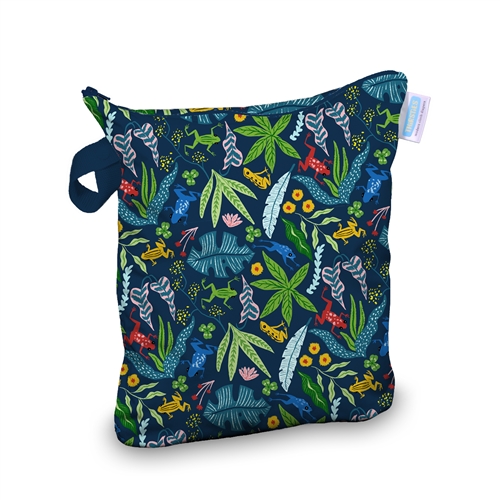
prefold diaper closures
Snappis are the modern version of pins. These can be used to get a really tight fit around baby to minimize leakage onto the diaper cover. Snappis are optional, but good to have on hand as you discover your diapering preference.
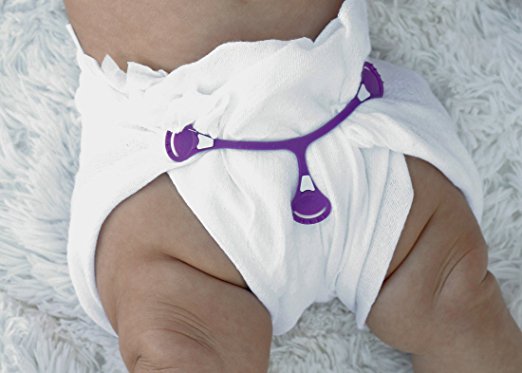
diaper pail
You can use any diaper pail if you wash at home every 2 to 3 days, but if you are washing less than that per week or using a service, you will need something that is at least 13 gallons.
diaper bag for pail
Reusable pail liners made of PUL material can be washed with diapers. Avoid trash bags all together.
cloth wipes or disposable wipes
Wipes are used to clean baby's bum between diaper changes. You can use 100% cotton flannel wipes as an alternative to purchasing disposable wipes. Reusable wipes are washed with your diapers. We recommend using Babybits solution in a spray bottle or a diaper warmer to wet the wipe prior to use.

rash balm
It is good to have a cloth diaper compatible cream or balm at home in the event that your baby develops some redness. Coconut oil is a great everyday preventive product. Common rash creams such as Destin and Aquafor cannot be used with cloth diapers because they contain petroleum, which impacts the absorbency and stains cloth diapers.
doubler
This is an extra layer of absorbency used during nights or naps. It usually comes in a rectangular or hour glass shape and can be made from microfiber, cotton, hemp, wool, or a combination of these. We offer a
fleece lined up-cycled doubler that keeps baby dry during those long stretches.
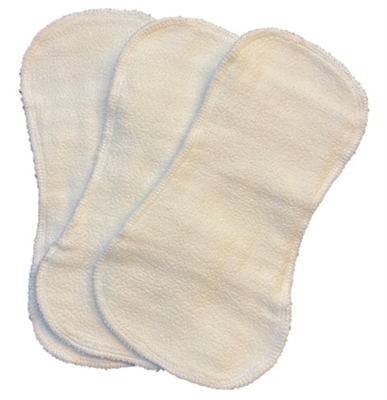
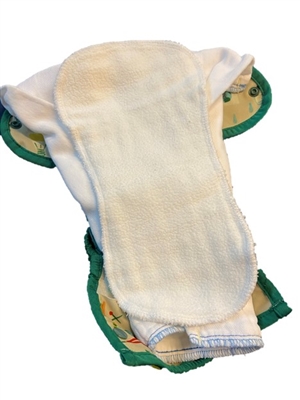
toilet spray attachment and pail
Washing diapers at home is pretty simple if you have convenient access to a washing machine. Until baby is eating solids (around 6 months old) you just put the soiled diapers directly in your washer. Once there is solid poop, you will need to dump it in your toilet before washing. You can use a spray attachment and container to help with this process without dirtying your hands. If the poop doesn't just pop off the diaper into the toilet, the old fashion way is to dunk the diaper. There is no need to spray, soak, or rinse every diaper, modern washing machines can handle the dirty work.









